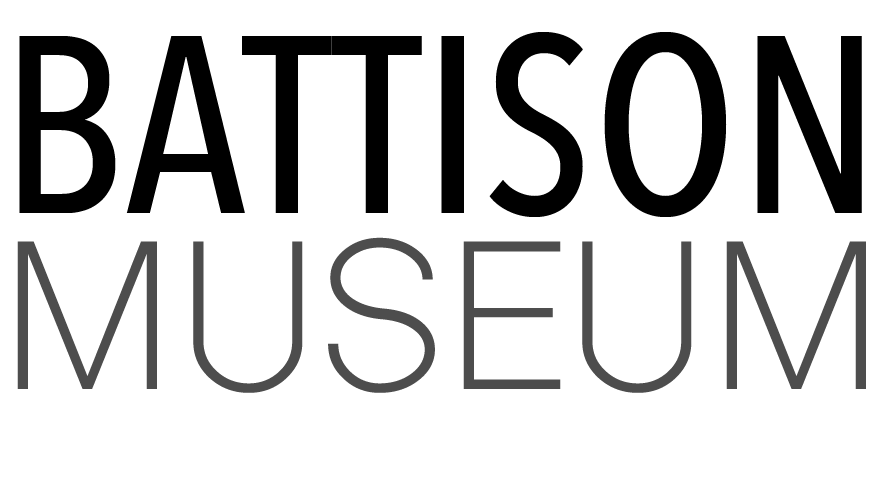Cast of Characters Part 1 - Mentoring
Nathan “Fred” English, his wife Emily (Livermore), her brother Benjamin Livermore
and
The English children: Analdo, Ernest and Euler
and
Their protégé Edwin Battison
Introduction
This is a three-generation story of a talented family mentoring an inquisitive young man. All these players except Emily, the family’s binding energy, are the cleverest individuals you could imagine. Their lives spanned the years 1822 to 1939. In that last year, Analdo and Ernest, and Edwin’s father Albert died within a few months of each other. I have only included some of Edwin’s diary entries for years 1929-1934 that reflect his direct interactions with Analdo and Ernest English and their references to Nathan “Fred” English (1822-1902) and Benjamin Livermore (1818-1874?).
In some of the entries below I have added an italicized comment in parentheses to give the reader a better understanding, context or clarification of the matter at hand.
The diaries start as the Great Depression begins, money is tight, work for adults is limited, so everyone in the family must contribute as best they can. Edwin is 13-years old.
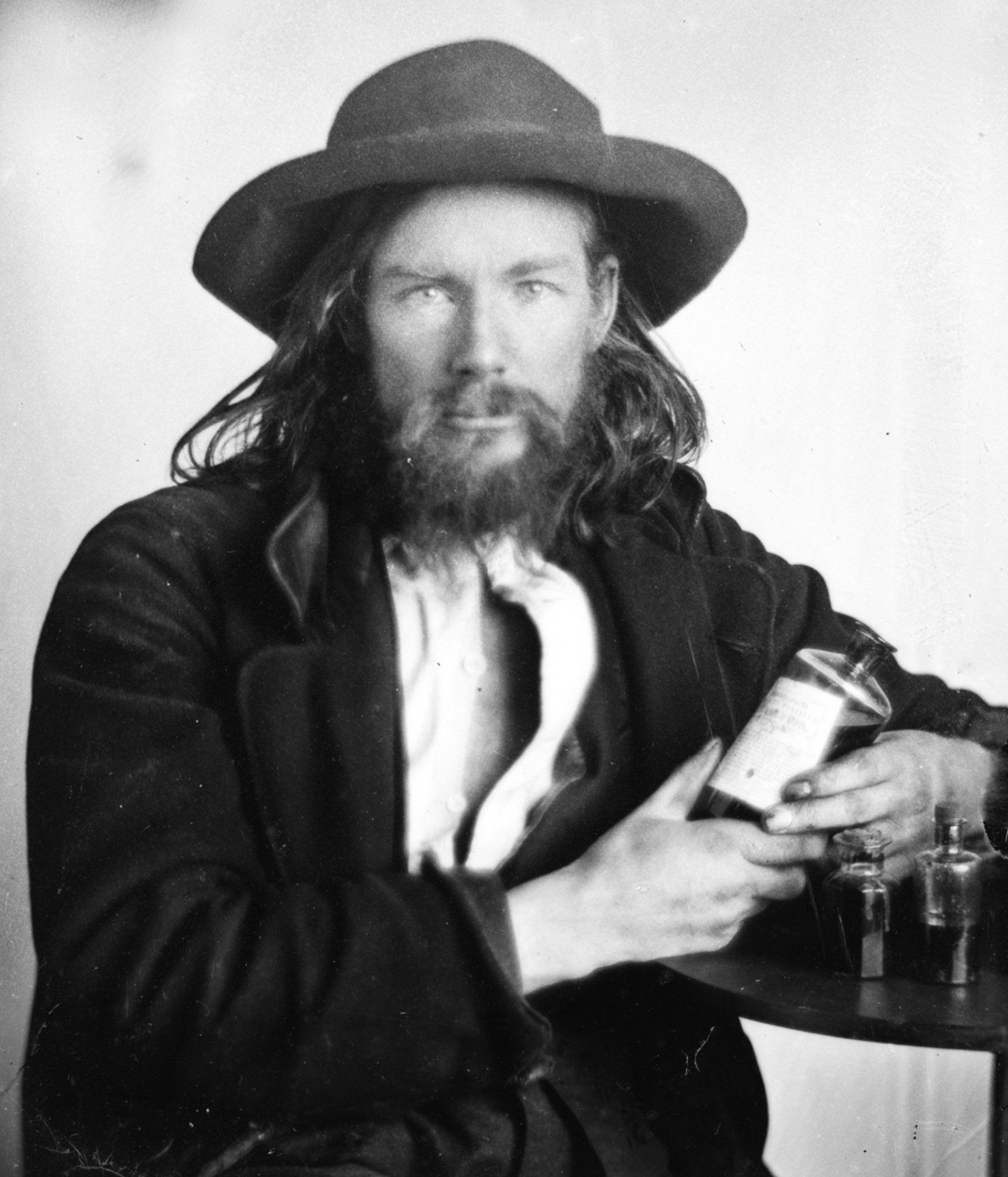
Nathan Fredrick ‘Fred” English holding a vial of a chemical used in a photographic process. He was a photographer, mechanic and inveterate inventor.
March 27, 1929 Wednesday. Not much to say… Got some junk tonight about 9 cents worth.
March 28, 1929 Thursday. Sold all the junk I got since last Thursday. Got $3.19. Goodman (the junk man)
owes me 18 cents. Took my art lesson tonight.
March 29, 1929 Friday. I got a $1.00 worth of junk to sell. I brought home and sold machine for rolling sheet metal. It came from the Hubbard Print Shop. This shop is leaving town. (his father, a trained machinist, would work there until the shop was a shell of its former self. This was a common occurrence in historically industrial Windsor, prompting many public labor meetings, most attended by father and son). Pa says the rolling machine is about 100 years old…used by a jeweler.
April 4, 1929 Wednesday. Sold junk to Goodman but he forgot to pay me. Might forget to sell him any more junk. (Edwin had pluck).
May 30, 1929 Thursday Memorial Day. I got a telephone arm off Mr. English at Hartland. (Ernest English started the Hartland Telephone Company in 1893. He was its owner, manager and builder. His wife Jennie Tarble was secretary, treasurer and switchboard operator.)
Also a transmitter.
He has some machines used in the Robbins and Lawrence Armory at Windsor (In 1845 that company received the first ever government contract to produce 10,000 military firearms with interchangeable parts. Their home-grown machinery was revolutionary.)
January 24, 1932 Sunday. This afternoon I started out for a short walk but got picked up by Cranford’s milk truck, so I went to the English’s. His brother (Analdo)
is living there now (In 1872, Analdo moved to Rhode Island working as a professional inventor. He retired at age 83 and came home to freelance in his trade).
February 27, 1932 Saturday. Made arrangements with Cranford’s milk truck to take me and Bert to Hartland. Mr. English turned up a stud for my rolling machine. He had found it while walking along the river looking for junk. He was working at rebuilding the shaper and his brother was working on a metronome. His fathers small bench lathe was set up for that purpose… Got a ride home on a lumber truck. Was real cold riding both ways.
April 4, 1932 Monday. Went up to Mr. English’s. I got a ride both ways so that in all I only had to walk 3 miles. First, I stopped at Jimmie Morgan’s and tried to trade him some dentist tools for some bullet molds. He would not trade. Spent most of the time at the English’s. He gave me a pair of tooth extraction forceps invented by his father (N. Fred English)
in the 1850’s and made by Robbins & Lawrence. He also gave me the castings to the 10-inch lathe except the head stock casting that was never made. . .. This evening I went to the library.

A tooth extractor was one of Fred's dozens of inventions.
April 25, 1932 Monday. Father, Alvin and I went to the English’s this afternoon. He helped me some on the problem about my lathe but Father stood around with his fingers on the latch (door handle)
so I did not gain much. He (Ernest)
was sorting books had them on the planer, benches etc and gave me Vol 2 of report on Perry’s artic expedition in the 1840’s. It is illustrated with colored plates.
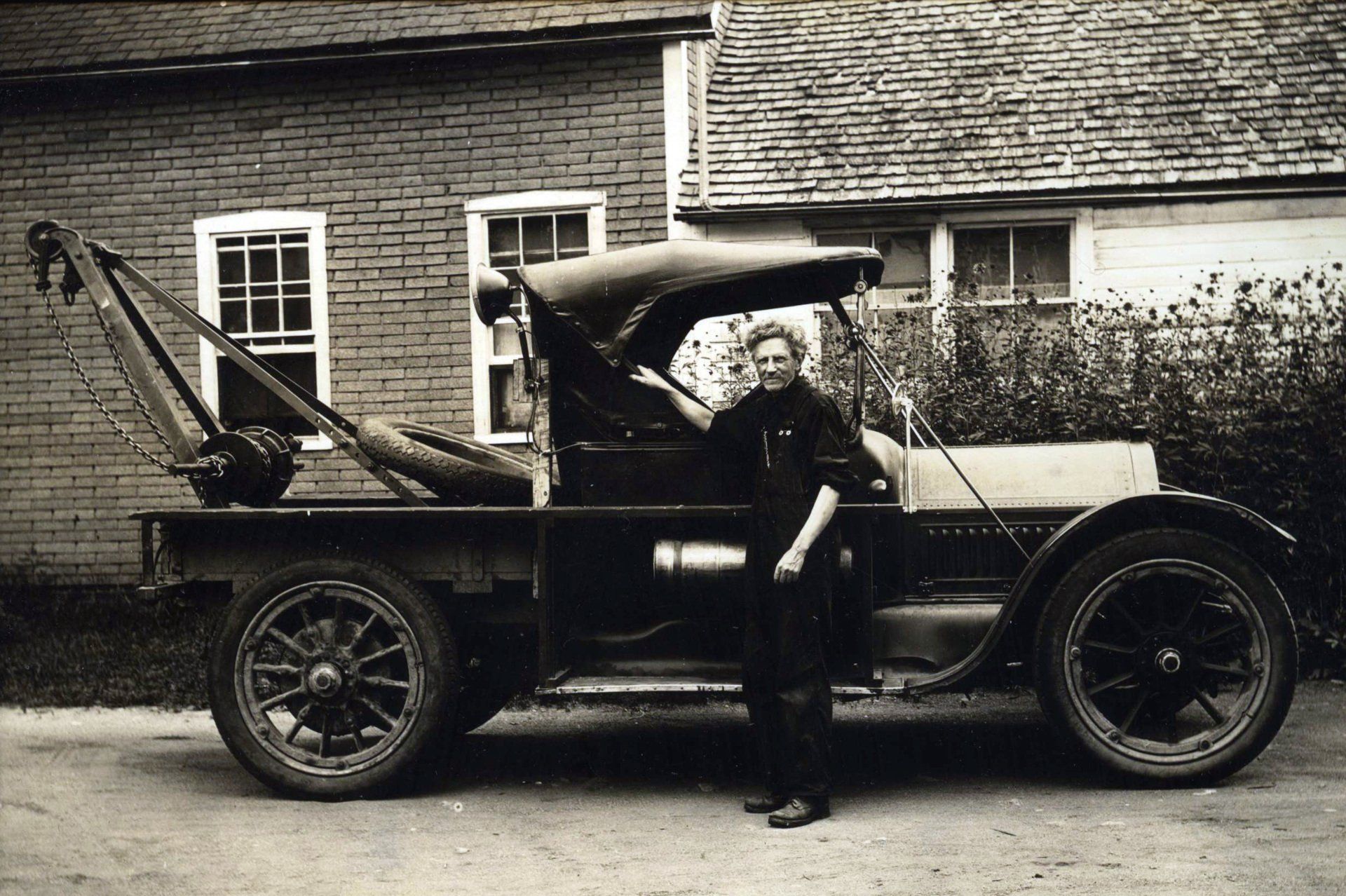
Fred's son Ernest English with the truck he made from a 1913 Cadillac chassis.
November 12, 1932 Saturday. I had 2 back teeth pulled by Doctor Hutchins this morning. They are the first of my second teeth to go. He refused to use my forceps.
A special note:
In 2003, I took Edwin to the Vermont History Expo, an annual gathering of the state's historical societies, small museums and all things historic. As its curator, I had organized Hartland Historical Society’s display, titled The English Family and their Protégé Edwin Battison. I also brought his elegant, nickel-plated forceps mentioned above. The novel way it worked was that as a dentist squeezed the handles together, the first action was for the first set of pinchers to anchor onto a good tooth adjacent to the one that had to be pulled. With further squeezing, a second set of pinchers grabbed that bad tooth, jerking it up and out, the anchored pincher acting as the fulcrum. That was how it worked, at least in theory.
On our exhibition table, beside the forceps, was our sign reading Demonstration at Noon. Volunteers Wanted. We had no takers, but people laughed, including a dentist. “Will never work” he said, “you can’t pull a tooth straight out, you have to twist and wiggle it out”. Then Edwin laughed, agreeing, “Yes, it was an unsuccessful invention, failure is a very important factor. That’s why it never made it to the market and disappeared, except for the two dozen I have in storage”. One pair of forceps at least has gone on to another life, as I sold it to the American Pickers for display in their store. We have Fred’s working patent models, with carrying cases, and his dental anatomy books.
June 30, 1932 Thursday. This afternoon I went up to Englishes with my lathe drawings. The old fellows were tickled pink.
September 27, 1932 Sunday. I went up to English’s in Hartland. I spent some time with Ernest but more with Analdo (age 83) who is working on the silent metronome. He has so far built 4 or 5 models, now nearly complete in a case and running
.
November 22, 1932 Tuesday. Very cold, overcast with snow squalls until nearly noon when the sun came out. Went to Hartland with Brad Cranford’s brother and walked from there to Englishes. I gave him some tools and we talked about the lathe I was getting up.
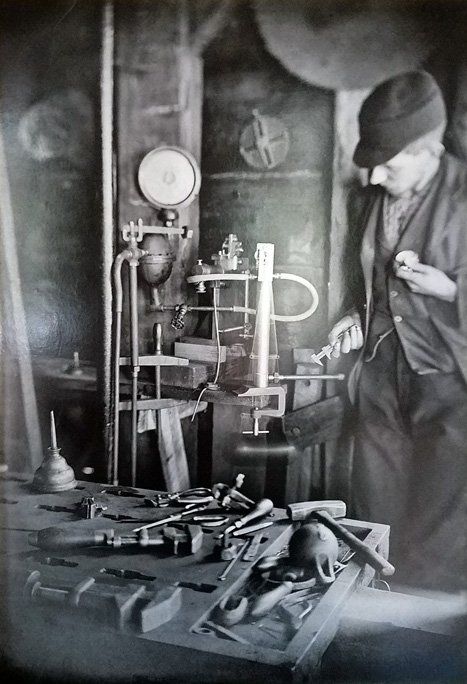
In the shop, experimenting, is Analdo English who was issued 31 US patents.
January 13, 1934 Saturday. I wanted to go to Hartland to-day but didn’t. The Vermont Journal (area newspaper first published in Windsor in 1783- Edwin read a lot there) says that the diamond-toothed saws of large diameter are used to cut stone. Earnest English’s father built such a saw 50 or 60 years ago. The diamonds were set staggered like pins in a music box. It was tried out at a marble quarry over Rutland way and was a partial success. Like about everything else he ever invented he dropped it before it was perfected, as everything else seemed more promising. Come to think of it he got it up about the time of Lamson-Wardwell suit over stone channeling machines (Fred was involved in the legal proceedings. See Analdo’s letter mentioned in the 3rd to last paragraph below.)
April 25, 1934 Thursday. I was in the mill gorge later. (located in Hartland, today the site of my hydroelectric power plant). I walked from there to the Englishes. He threaded the piece I turned up for a pin screw to keep the collet in my jeweler’s lathe from turning. I was under the ridge pole of the shop looking over patterns. (They are generally wooden forms in the shape of an object that is to be reproduced in a sand-casting process. The Englishes were the masters of this trade, their house and shops adjacent to the foundry in Hartland’s village of Foundryville.) There are patterns for about everything, all kinds of lathes, steam engines, mill gearing, water wheels, grinders and all their parts, shoe machinery patterns, model machine parts etc. I got a pattern for a small “C” clamp, part of a dividing head (the horizontal swivel), offset tool block for a lathe and a 4” 3 spoke handwheel. I must look up more later. I went over by the old Hendricks place and out on the old County Road at Craig’s where nothing would do but I must eat dinner.
As a reminder to you the reader, the above 14 diary entries are a sampling of the 12,000 or so that Edwin wrote.
I have not yet written about Fred’s youngest son Euler who moved to Minneapolis in 1888. His 1934 obituary describes his own extraordinary inventive abilities. Euler was also the pilot of Fred’s first attempt at human powered flight, "flying" the family’s ornithopter from their home’s upper story to the foundry shop across the road.
Benjamin Livermore and Fred English died before Edwin was born, but their influence on him, as he told me, was immense. Here is an example.
Benjamin Livermore was as good a mechanic as his brother-in-law Fred was a machinist. They collaborated on some inventions, sharing tools and ideas, an easy thing to do as they lived a short walk from each other. Their projects ran a broad spectrum: boot lasting machines, cement drains, wire thread for sewing leather, photographic apparatus, quarry stone cutter and more.
But there was one ingenious object conceived by Benjamin that sets him aside, the first manual typing machine, a Typograph or Pocket Printing Machine. It is the precursor to the typewriter. It’s a permutation style device, meaning that letters and number don’t have specific keys. It uses only 8 keys that form the structure of those characters. Using one hand the typist presses a combination of keys to form a single letter or number that then imprints that character on a narrow roll of paper. After a key is released, the “print head” shifts over one position, ready for the next character in a word. The mechanism made of little tabs of bent sheet metal, wire linkages and springs, is complex. Including the keys. It is not much bigger than a cigarette package. The first model was made in 1854, the 11th and final one in 1873.
Benjamin’s nephew, Analdo, mastered its writing style, sometimes using it to write letters home. One letter written to his father Fred congratulates him on the quarry machine mentioned above, as well as a witty comment on the cold and windy weather in Rhode Island.
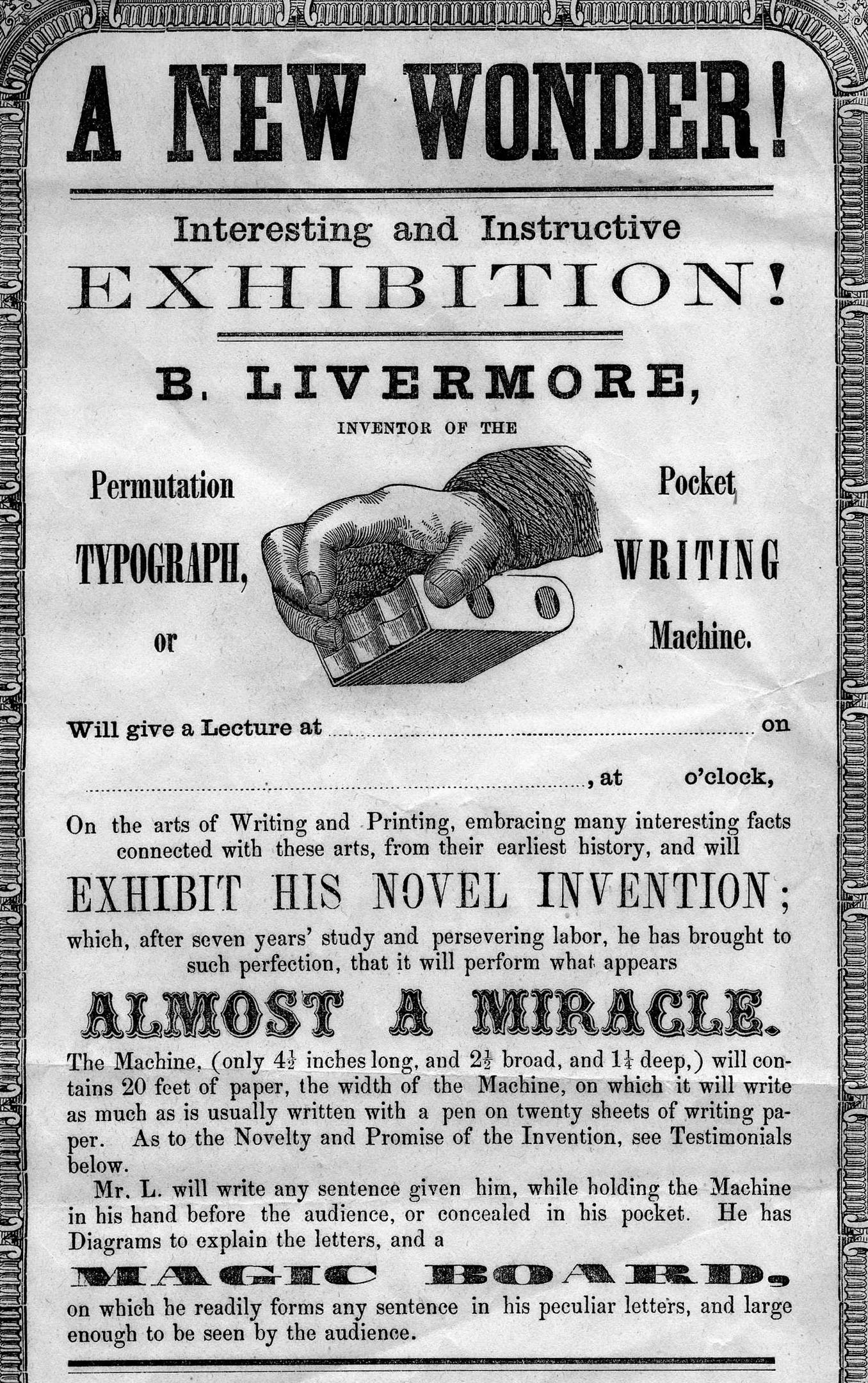
Benjamin Livermore's advertisement for his typograph, complete with testimonials.
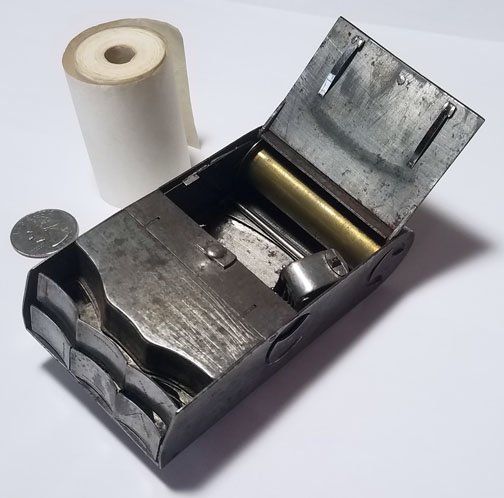
The 1873 patent model typograph, a roll of recording paper and a quarter to show its scale.
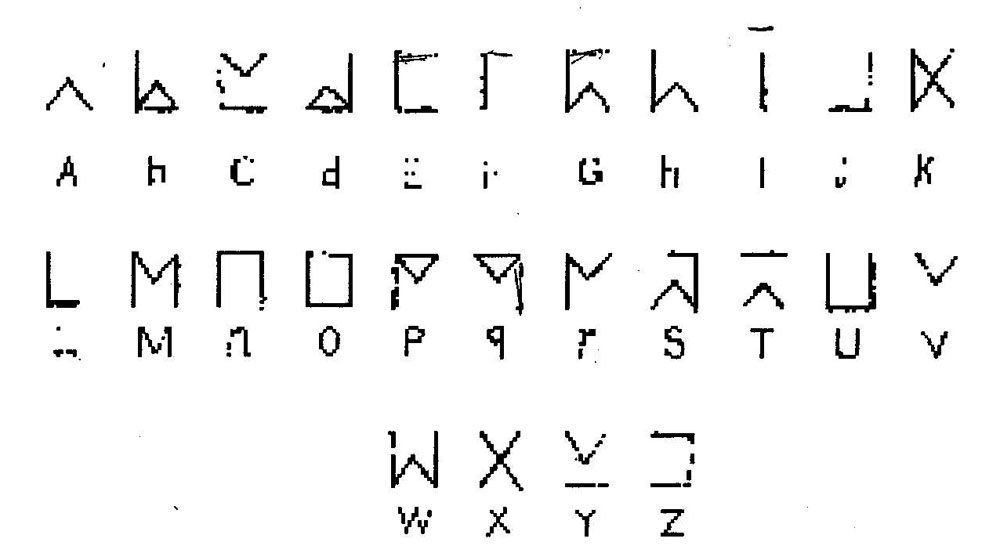
The typograph’s translation code for the characters made by its 6 keys.
Rounding out this story was Fred’s contribution. Amongst everything else, he was a portrait daguerreotypist and glass plate landscapist. He immortalized the completed typograph in a family style daguerreotype. It pictures Benjamin, his sister Emily, her three daughters and son Analdo, with the 8-keyed typograph nestled front and center.
Ernest and Analdo and their surviving contemporaries gave Edwin all Benjamin’s typograph models and literature, Fred’s machines, tools, papers, and much of his image portfolio. A few years ago, I found the famous family daguerreotype. Edwin’s roommate in his nursing home was an English family descendant from Hartland, a fact we didn’t know until a day after he died. The dag had found its way to a dealer, then after a little detective work, to us.
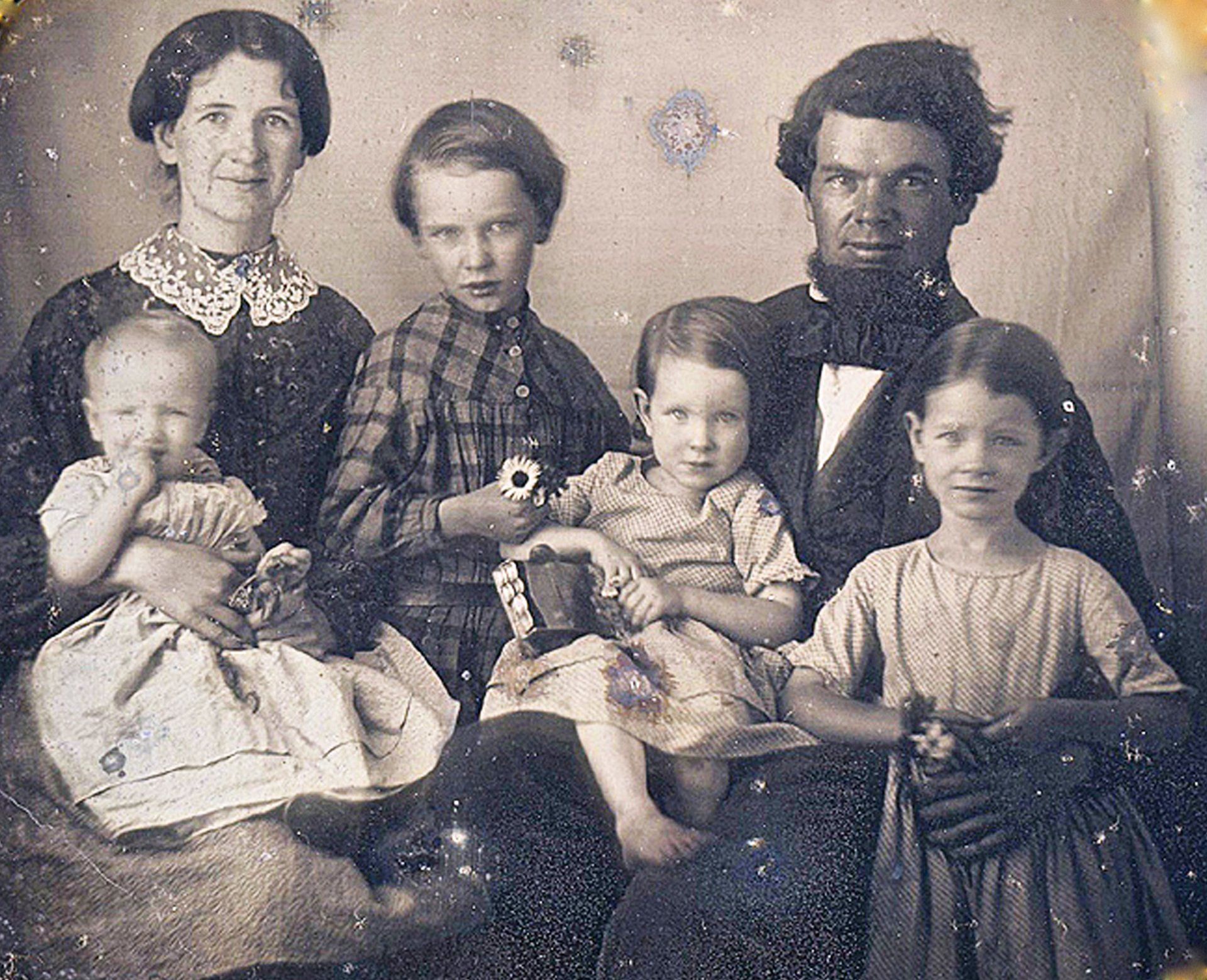
A daguerreotype of Emily English, her three daughters, Analdo (with the flower) and her brother, Benjamin Livermore, and the typograph nestled in the middle. Photographer is Fred English.

The foundry in Hartland, across from English’s shop. Fred and his 3 sons (shown in his photograph) were masters at pattern making, casting and finish machining.
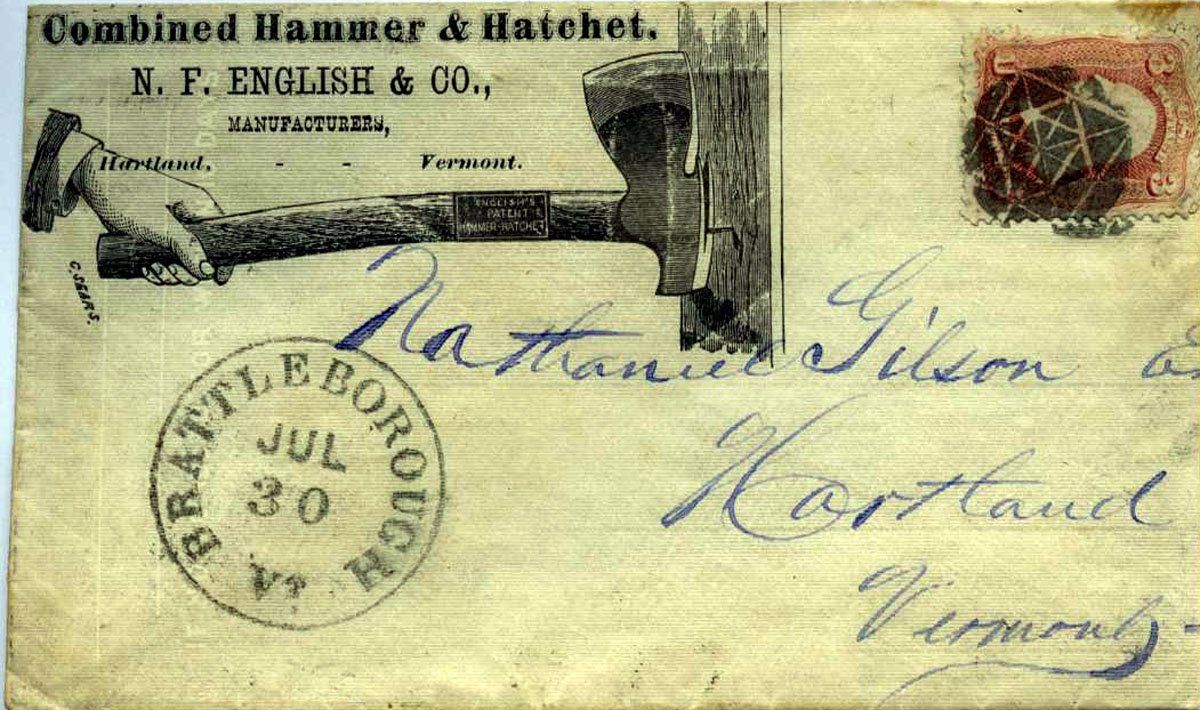
Another Fred English invention, a combination Hammer-Hatchet.
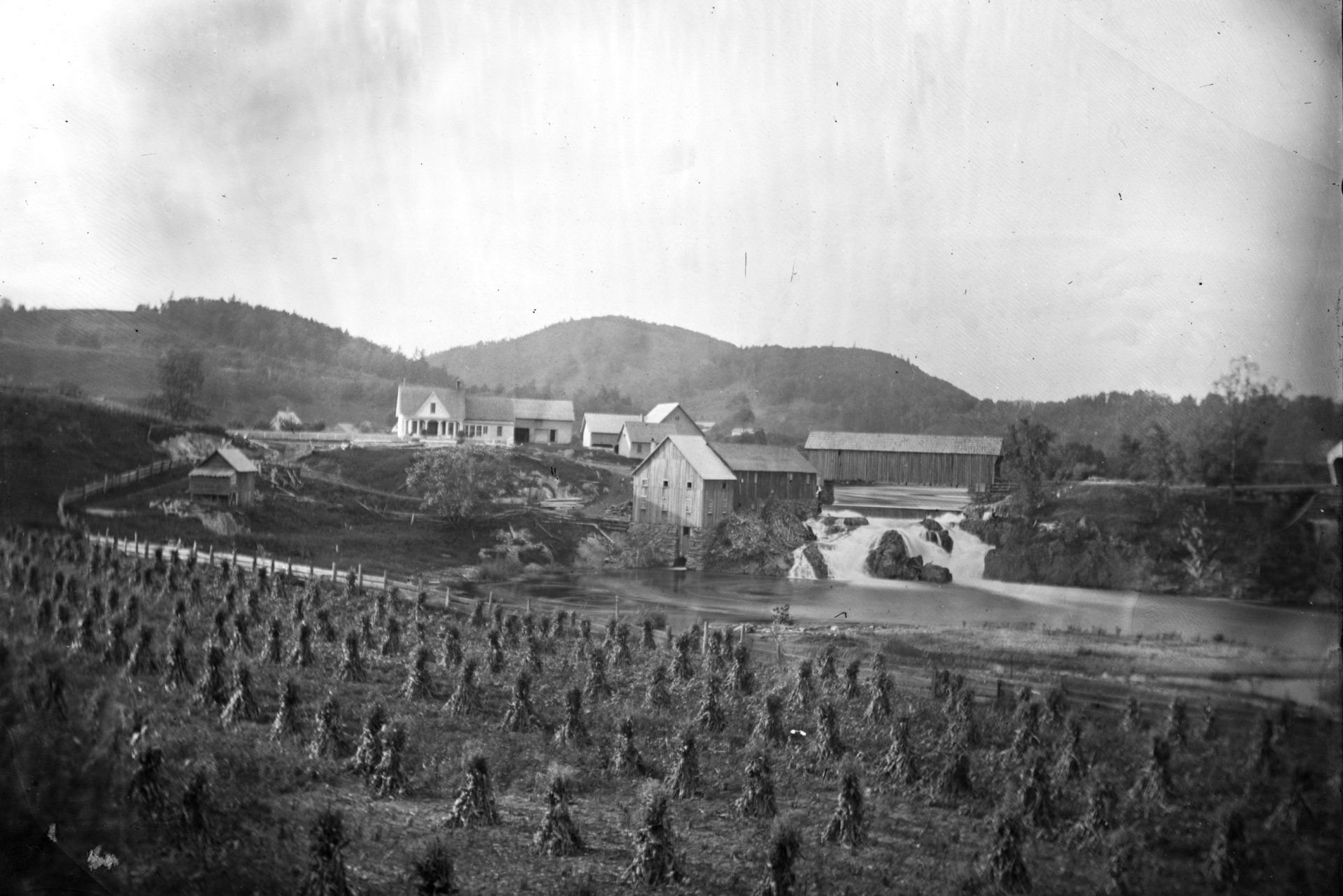
Fred English's eye for composition. This is from his glass plate of the Twin Falls of the Ottaquechee River near its confluence with the Connecticut River.
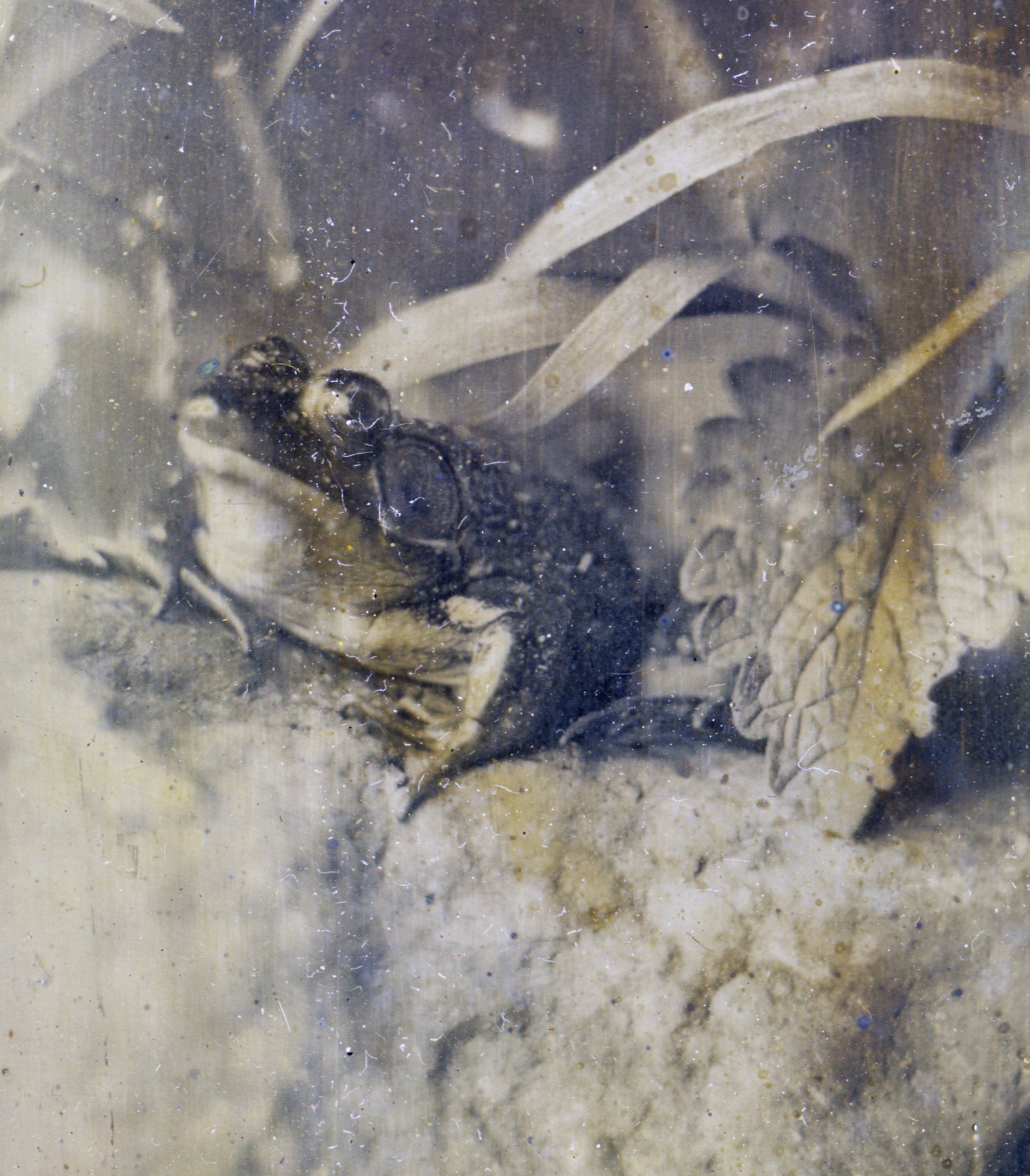
His daguerreotype of a wee frog in the wild. Fred ground his own lenses for cameras and microscopes.
